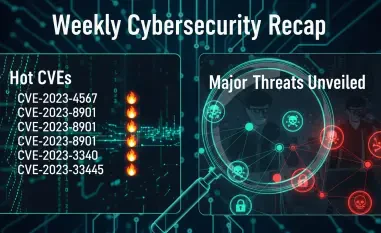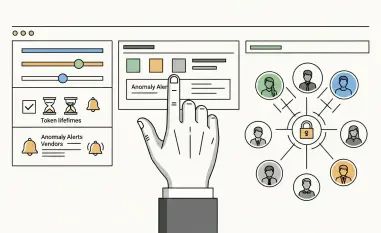In a chilling reminder of the persistent dangers lurking in the digital realm, a major cybersecurity breach at F5, a leading application security vendor, has sent shockwaves through the tech and government sectors, highlighting the critical need for robust defenses. Discovered several months ago and publicly disclosed in late 2024, this incident involved a sophisticated nation-state actor infiltrating critical systems, including the BIG-IP product development environment and engineering knowledge platforms. The theft of sensitive data, such as source code and undisclosed vulnerabilities, has raised alarms about the potential for devastating exploits that could compromise both federal and private networks. As the implications of this breach unfold, the urgency to address vulnerabilities and bolster defenses against advanced persistent threats (APTs) has never been more apparent. This incident not only exposes the fragility of supply chain security but also underscores the growing audacity of state-sponsored cyber warfare.
Unpacking the Breach and Its Immediate Fallout
Scope of the Intrusion and Stolen Data
The breach at F5 represents a stark example of how even well-protected entities can fall prey to determined nation-state actors. Unauthorized access was gained to pivotal systems, resulting in the extraction of critical files, including the source code for BIG-IP products and details of previously undisclosed vulnerabilities. This theft poses a severe risk, as adversaries could analyze the data to uncover zero-day exploits, potentially crafting targeted attacks that evade existing defenses. The affected systems also included engineering knowledge management platforms, which contained configuration and implementation data for a small subset of customers. While there’s no evidence of tampering with software supply chains or other core systems, the stolen intellectual property could still enable attackers to compromise networks on a massive scale. The gravity of this situation has prompted immediate calls for action to mitigate risks before malicious actors capitalize on their ill-gotten gains.
Beyond the immediate data theft, the breach highlights a broader concern about the security of application-layer technologies that underpin countless networks. Federal agencies and private enterprises relying on F5 products now face the daunting task of assessing their exposure to potential exploits derived from the stolen information. The incident serves as a wake-up call about the sophistication of state-sponsored threats, which often operate with extensive resources and long-term strategic goals. Such actors may not only exploit vulnerabilities for immediate gain but also embed themselves within systems for future command and control operations. This breach, therefore, is not merely a singular event but a potential precursor to more systemic attacks, emphasizing the need for heightened vigilance and robust security measures across all sectors that depend on F5’s widely used solutions.
F5’s Response and Containment Efforts
In the wake of discovering the breach, F5 swiftly moved to implement comprehensive containment measures to halt further unauthorized access. Reports indicate that no new intrusions have occurred since these efforts began, suggesting that the company’s response has been effective in curbing immediate threats. Internally, security has been fortified through enhanced access controls, improved inventory and patch management, and stronger network monitoring, particularly around development platforms. F5 has also urged customers to apply the latest security updates across a range of products, including BIG-IP, F5OS, BIG-IP Next for Kubernetes, BIG-IQ, and APM clients. These updates, detailed in a recent Quarterly Security Notification, are critical to safeguarding systems against potential exploits stemming from the stolen data. The company’s proactive stance reflects an understanding of the high stakes involved in this incident.
Additionally, F5 has provided actionable guidance to support its customer base in navigating the fallout from this breach. Recommendations include proactive threat hunting and system hardening using tools like the iHealth Diagnostic Tool, as well as enabling BIG-IP event streaming to SIEM systems for real-time monitoring of suspicious activities, such as unauthorized admin logins or configuration changes. While these steps are crucial, they also underscore the shared responsibility between vendor and customer in maintaining cybersecurity. The breach has exposed vulnerabilities not just in F5’s systems but in the broader ecosystem of trust and dependency that characterizes modern IT infrastructure. As containment efforts continue, the focus remains on preventing the stolen data from being weaponized, a task that requires sustained collaboration and vigilance across all affected parties.
Broader Implications and Calls for Action
Government Mandates and National Security Concerns
The severity of the F5 breach has prompted a swift response from governmental bodies, with the US Cybersecurity and Infrastructure Security Agency (CISA) issuing an emergency directive to address the looming threat. Federal agencies have been instructed to evaluate whether their F5 management interfaces are exposed to the public internet and to implement necessary patches without delay. CISA’s warning paints a dire picture of the potential consequences of exploitation, including compromised credentials, lateral movement within networks, data exfiltration, and persistent access that could lead to full system compromise. This directive reflects a recognition of the imminent danger posed by the nation-state actor’s access to sensitive data and the urgent need to secure critical infrastructure against such advanced threats. The government’s involvement elevates the incident to a matter of national security.
Moreover, the breach underscores the growing trend of supply chain attacks as a preferred tactic in modern cyber warfare, a concern echoed by industry experts and authorities alike. The stolen data could serve as a stepping stone for broader campaigns targeting interconnected systems, amplifying the risk to both public and private sectors. Experts have highlighted that nation-state actors often use such breaches to establish long-term footholds for espionage or disruption, making early detection and response paramount. CISA’s stern guidance, combined with expert consensus, positions third-party risk as a critical national security issue, necessitating a reevaluation of how supply chain vulnerabilities are managed. The incident serves as a catalyst for stronger regulatory oversight and collaboration to fortify defenses against adversaries who exploit systemic weaknesses with alarming precision.
Expert Insights and Future Preparedness
Industry voices have added depth to the discourse surrounding the F5 breach, framing it as a harbinger of more sophisticated supply chain attacks. Cybersecurity leaders stress that nation-state actors frequently leverage stolen intellectual property to develop zero-day exploits, a risk that demands urgent assessment of exposure among affected customers. The emphasis on application-layer detection and response (ADR) highlights a shift toward more granular security measures to counter these threats. Such attacks are not isolated but part of a broader strategy to undermine trust in digital ecosystems, making it imperative to treat supply chain vulnerabilities as existential risks. The consensus is clear: organizations must prioritize rapid patching and enhanced monitoring to prevent adversaries from exploiting the stolen data in future campaigns.
Looking back, the response to this breach also revealed the importance of collective action in the face of advanced persistent threats. Insights from thought leaders pointed to the need for systemic changes, including treating third-party risk with the same gravity as direct attacks on infrastructure. As the dust settled, the incident prompted a renewed focus on building resilient defenses through innovative tools and strategies. Reflecting on past efforts, it became evident that fostering a culture of preparedness—through regular updates, threat hunting, and cross-sector collaboration—offered the best path forward. The lessons learned from this breach paved the way for actionable steps, such as integrating advanced monitoring solutions and advocating for stricter supply chain security standards, ensuring that future incidents could be met with stronger, more coordinated resistance.













